The Subcutaneous Drug Delivery Market is estimated to be valued at USD 34.9 billion in 2025 and is projected to reach USD 66.7 billion by 2035, registering a compound annual growth rate (CAGR) of 6.7% over the forecast period.
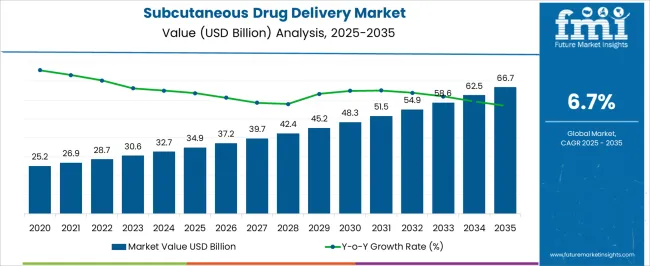
| Metric | Value |
|---|---|
| Subcutaneous Drug Delivery Market Estimated Value in (2025 E) | USD 34.9 billion |
| Subcutaneous Drug Delivery Market Forecast Value in (2035 F) | USD 66.7 billion |
| Forecast CAGR (2025 to 2035) | 6.7% |
The Subcutaneous Drug Delivery market is experiencing sustained growth, driven by the increasing adoption of self-administered therapies and biologics requiring frequent dosing. The current market scenario reflects a strong preference for patient-centric delivery solutions that reduce dependency on hospital visits and improve treatment adherence. Expanding prevalence of chronic diseases, such as diabetes, autoimmune disorders, and cancer, has accelerated the demand for subcutaneous injection systems.
Continuous innovation in device design, including ergonomic prefilled injectables and disposable delivery systems, is enhancing usability and safety, supporting broader patient adoption. Future outlook is shaped by ongoing development of combination devices, needle-free injectors, and digital tracking-enabled drug delivery platforms.
Investments in personalized medicine, coupled with growing awareness of homecare options, are expected to further drive market expansion As healthcare systems increasingly prioritize convenience, compliance, and safety, the subcutaneous drug delivery market is poised to see strong growth across both developed and emerging regions.
The subcutaneous drug delivery market is segmented by product type, usability type, technology, distribution channel, and geographic regions. By product type, subcutaneous drug delivery market is divided into Prefilled Injectable and Fillable Injectable. In terms of usability type, subcutaneous drug delivery market is classified into Disposable subcutaneous drug delivery injectable and Reusable subcutaneous drug delivery injectable. Based on technology, subcutaneous drug delivery market is segmented into Spring, Jet, and Gas. By distribution channel, subcutaneous drug delivery market is segmented into Hospital Pharmacies, Retail Pharmacies, Drug store, and Online Pharmacies. Regionally, the subcutaneous drug delivery industry is classified into North America, Latin America, Western Europe, Eastern Europe, Balkan & Baltic Countries, Russia & Belarus, Central Asia, East Asia, South Asia & Pacific, and the Middle East & Africa.
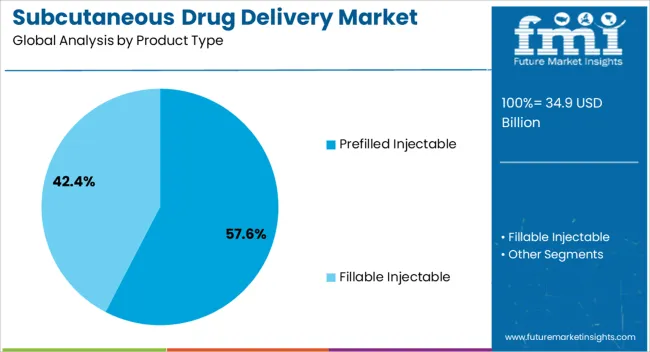
The prefilled injectable product type is projected to hold 57.60% of the subcutaneous drug delivery market revenue in 2025, establishing it as the leading product type. This dominance is being attributed to the convenience, dosing accuracy, and reduced risk of contamination associated with prefilled systems. Prefilled injectables enable simplified administration, particularly for chronic disease patients requiring frequent self-injections, and reduce the burden on healthcare providers.
The format allows for consistent dosing and improved patient compliance while minimizing errors compared with traditional vial and syringe systems. Growth is also supported by the expansion of biologic therapies and high-value drugs that require precise delivery, which aligns with the prefilled format’s operational and safety advantages.
Increasing awareness among patients and caregivers about proper injection techniques has further strengthened adoption As manufacturers continue to invest in prefilled injectable development, this segment is expected to maintain its leading market position due to its combination of efficiency, safety, and ease of use.
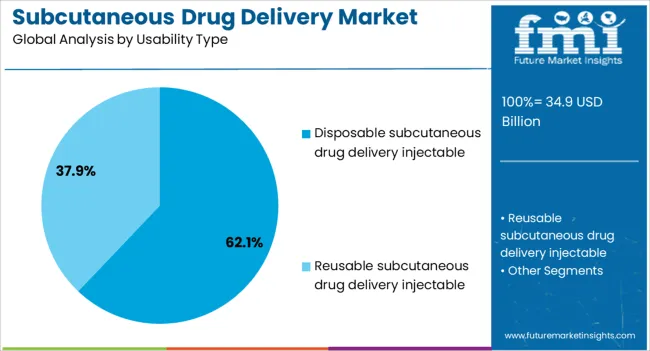
The disposable subcutaneous drug delivery injectable usability type is anticipated to hold 62.10% of the market revenue in 2025, making it the dominant usability segment. Its leadership is being driven by the need for devices that reduce infection risks and simplify patient administration at home or in outpatient settings. Disposable systems eliminate the need for sterilization and device maintenance, enhancing safety and convenience, particularly for chronic therapy patients.
Adoption has been supported by growing demand for user-friendly, self-administered devices that can be disposed of safely after a single use, minimizing cross-contamination and biohazard risks. The integration of safety features, including automatic needle retraction and ergonomic design, has further increased patient confidence and adherence.
Increasing awareness of homecare treatment benefits, coupled with healthcare systems prioritizing cost-effective and scalable solutions, has propelled the growth of disposable injectables Continued innovation in this segment is expected to solidify its market leadership due to its combination of safety, ease of use, and alignment with patient-centric healthcare models.
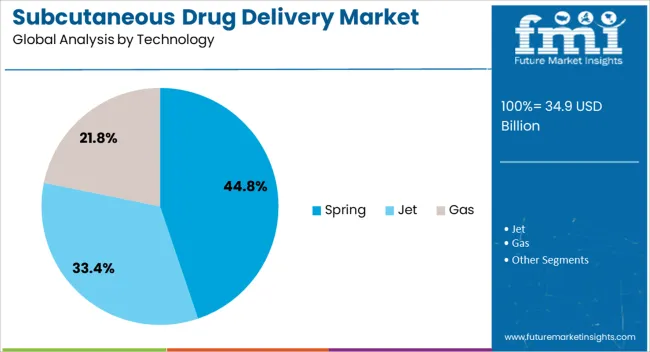
The spring-based technology segment is estimated to capture 44.80% of the subcutaneous drug delivery market revenue in 2025, positioning it as the leading technology type. This prominence is being attributed to the reliable and controlled drug delivery mechanism offered by spring-driven systems, which ensures precise dosing and consistent injection performance. Spring technology enables smooth, automatic administration, reducing the skill required for self-injection and minimizing patient anxiety associated with manual injection.
Its adoption has been accelerated in chronic disease management and biologic therapy administration, where accuracy and safety are critical. The compact and mechanically robust nature of spring-based devices also supports their integration into prefilled and disposable systems, reinforcing cross-segment growth.
Enhanced patient experience, reduced risk of under- or over-dosing, and compatibility with multiple drug formulations have contributed to its leading position As manufacturers continue to optimize spring-driven designs for comfort, reliability, and safety, this technology segment is expected to maintain a dominant role in the subcutaneous drug delivery market.
Subcutaneous drugs are injected in the layer of the skin called the cutis, which comprises the epidermis and dermis. The subcutaneous parenteral route of drug delivery is effective for administrating vaccines and for sustained release drugs and for insulin, goserelin etc. Numerous pharmaceutical products are marketed and being developed for various diseases which are administered through subcutaneous routes.
Drug manufacturers are also majorly focusing on packaging and effective delivery options for easy administration processes so that the drug can be introduced to the patient with reliability. As many pharmaceutical companies are developing self-administered drugs, several subcutaneous drug delivery devices have witnessed a high adoption rate.
Due to these findings, major opportunities now exist for innovative approaches to subcutaneous drug delivery devices for many leading players in the subcutaneous drug delivery market. The subcutaneous drug delivery market is growing as various advanced drug delivery devices are introduced in the market such as Jet injectors, Auto injectors, Mechanical pumps etc. Subcutaneous drug delivery systems are broadly used by end users due to the easy and reliable operating mechanism, thus generating large revenues in the subcutaneous drug delivery market.
On the other hand, the subcutaneous drug delivery market is gaining profit as conventional intravenous drugs are being replaced by subcutaneous drugs. The rapid technological advancement in subcutaneous injectable devices is attributed due to wearable patch pumps and wearable smart patch as they are prefilled and have thin needles, accommodates high dose volumes and are flexible to use. The global subcutaneous drug delivery market is expected to witness significant growth over the forecast period due to the rising prevalence of diabetes across the globe.
As per WHO 422 million of the adult population have diabetes in the US which represents a significant population and with an increasing diagnosis rate subcutaneous drug delivery market is further expected to witness growth. Increasing treatment seeking rate and spreading awareness about possible treatment options for diabetes is expected to fuel the subcutaneous drug delivery market.
Due to self-administered drugs, the administration of injectables moves increasingly from practitioner offices and healthcare facilities to patient homes.
As the subcutaneous route of administration is an effective alternative to the intravenous route of administration it is expected to future drive the growth of the subcutaneous drug delivery market. With the advent of single injector devices, auto-injectors, mechanical pumps and progress in digital medicine, it is anticipated growth in the subcutaneous drug delivery market.
Also, technical advancements like Bluetooth connectivity of glucometers also digital displays and touchscreen features in devices are expected to boost the demand for subcutaneous drug delivery technology market during the forecast period. Whereas, the high cost of these devices may hamper the growth Subcutaneous Drug Delivery market.
Many biological drugs such as monoclonal antibodies, protein-based therapeutics are under clinical trials and the subcutaneous route of administration is being investigated for their administration this is expected to contribute significantly to the Subcutaneous Drug Delivery market growth. Based on product type, fillable injectors register the highest revenue share in the subcutaneous drug delivery market owing to their reusability coupled with their less price and growing demand from patients.
As high demands for the combination of innovative drug-device products such as Insulin pumps and Omnipod for insulin from diabetic patients have contributed majorly to the growth of the market. Owing to this players are exploring new possibilities for developments in drug formulations and delivery device technology for subcutaneous drug delivery. The growing adoption rate of this subcutaneous drug delivery system is expected to fuel the demand for the subcutaneous drug delivery market.
On the basis of geography, global paraffin physical therapy market is segmented into seven key regions viz. North America, Latin America, Western Europe, Eastern Europe, Asia Pacific excluding Japan, Japan, and Middle East & Africa. North America is projected to hold largest shares in the global subcutaneous drug delivery market due to presence of leading manufacturer and advanced healthcare infrastructure. North America is the most lucrative Subcutaneous Drug Delivery market. Europe is expected to be second most lucrative Subcutaneous Drug Delivery market due to higher treatment seeking rate.
Asia-Pacific is regarded as emerging Subcutaneous Drug Delivery market due emerging economies such as India and China coupled with improving awareness among general population about treatment options. Latin America remains least lucrative Subcutaneous Drug Delivery market due to lowest adoption of Subcutaneous Drug Delivery as a treatment option.
The report is a compilation of first-hand information, qualitative and quantitative assessment by industry analysts, inputs from industry experts and industry participants across the value chain. The report provides in-depth analysis of parent market trends, macro-economic indicators and governing factors along with market attractiveness as per segments. The report also maps the qualitative impact of various market factors on market segments and geographies.
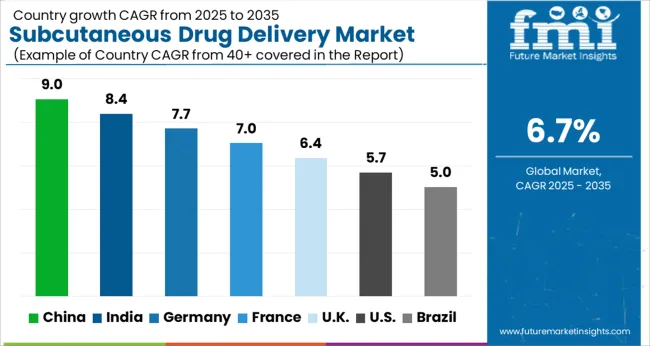
| Country | CAGR |
|---|---|
| China | 9.0% |
| India | 8.4% |
| Germany | 7.7% |
| France | 7.0% |
| UK | 6.4% |
| USA | 5.7% |
| Brazil | 5.0% |
The Subcutaneous Drug Delivery Market is expected to register a CAGR of 6.7% during the forecast period, exhibiting varied country level momentum. China leads with the highest CAGR of 9.0%, followed by India at 8.4%. Developed markets such as Germany, France, and the UK continue to expand steadily, while the USA is likely to grow at consistent rates. Brazil posts the lowest CAGR at 5.0%, yet still underscores a broadly positive trajectory for the global Subcutaneous Drug Delivery Market. In 2024, Germany held a dominant revenue in the Western Europe market and is expected to grow with a CAGR of 7.7%. The USA Subcutaneous Drug Delivery Market is estimated to be valued at USD 12.4 billion in 2025 and is anticipated to reach a valuation of USD 21.6 billion by 2035. Sales are projected to rise at a CAGR of 5.7% over the forecast period between 2025 and 2035. While Japan and South Korea markets are estimated to be valued at USD 1.7 billion and USD 914.5 million respectively in 2025.
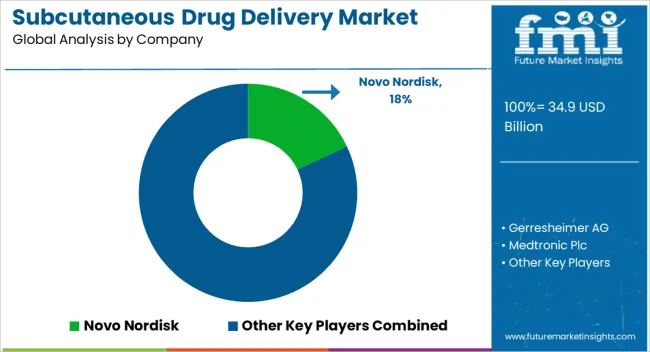
| Item | Value |
|---|---|
| Quantitative Units | USD 34.9 Billion |
| Product Type | Prefilled Injectable and Fillable Injectable |
| Usability Type | Disposable subcutaneous drug delivery injectable and Reusable subcutaneous drug delivery injectable |
| Technology | Spring, Jet, and Gas |
| Distribution Channel | Hospital Pharmacies, Retail Pharmacies, Drug store, and Online Pharmacies |
| Regions Covered | North America, Europe, Asia-Pacific, Latin America, Middle East & Africa |
| Country Covered | United States, Canada, Germany, France, United Kingdom, China, Japan, India, Brazil, South Africa |
| Key Companies Profiled | Novo Nordisk, Gerresheimer AG, Medtronic Plc, Ypsomed AG, Elcam Medical Group, Insulet Corporation, Becton, Dickinson and Company, West Pharmaceutical Services, Inc., PharmaJet, Unilife Corporation, and Inolife Sciences |
The global subcutaneous drug delivery market is estimated to be valued at USD 34.9 billion in 2025.
The market size for the subcutaneous drug delivery market is projected to reach USD 66.7 billion by 2035.
The subcutaneous drug delivery market is expected to grow at a 6.7% CAGR between 2025 and 2035.
The key product types in subcutaneous drug delivery market are prefilled injectable and fillable injectable.
In terms of usability type, disposable subcutaneous drug delivery injectable segment to command 62.1% share in the subcutaneous drug delivery market in 2025.






Our Research Products

The "Full Research Suite" delivers actionable market intel, deep dives on markets or technologies, so clients act faster, cut risk, and unlock growth.

The Leaderboard benchmarks and ranks top vendors, classifying them as Established Leaders, Leading Challengers, or Disruptors & Challengers.

Locates where complements amplify value and substitutes erode it, forecasting net impact by horizon

We deliver granular, decision-grade intel: market sizing, 5-year forecasts, pricing, adoption, usage, revenue, and operational KPIs—plus competitor tracking, regulation, and value chains—across 60 countries broadly.

Spot the shifts before they hit your P&L. We track inflection points, adoption curves, pricing moves, and ecosystem plays to show where demand is heading, why it is changing, and what to do next across high-growth markets and disruptive tech

Real-time reads of user behavior. We track shifting priorities, perceptions of today’s and next-gen services, and provider experience, then pace how fast tech moves from trial to adoption, blending buyer, consumer, and channel inputs with social signals (#WhySwitch, #UX).

Partner with our analyst team to build a custom report designed around your business priorities. From analysing market trends to assessing competitors or crafting bespoke datasets, we tailor insights to your needs.
Supplier Intelligence
Discovery & Profiling
Capacity & Footprint
Performance & Risk
Compliance & Governance
Commercial Readiness
Who Supplies Whom
Scorecards & Shortlists
Playbooks & Docs
Category Intelligence
Definition & Scope
Demand & Use Cases
Cost Drivers
Market Structure
Supply Chain Map
Trade & Policy
Operating Norms
Deliverables
Buyer Intelligence
Account Basics
Spend & Scope
Procurement Model
Vendor Requirements
Terms & Policies
Entry Strategy
Pain Points & Triggers
Outputs
Pricing Analysis
Benchmarks
Trends
Should-Cost
Indexation
Landed Cost
Commercial Terms
Deliverables
Brand Analysis
Positioning & Value Prop
Share & Presence
Customer Evidence
Go-to-Market
Digital & Reputation
Compliance & Trust
KPIs & Gaps
Outputs
Full Research Suite comprises of:
Market outlook & trends analysis
Interviews & case studies
Strategic recommendations
Vendor profiles & capabilities analysis
5-year forecasts
8 regions and 60+ country-level data splits
Market segment data splits
12 months of continuous data updates
DELIVERED AS:
PDF EXCEL ONLINE
Market Share Insights for Subcutaneous Drug Delivery Devices Providers
Subcutaneous Implantable Defibrillator System Market Size and Share Forecast Outlook 2025 to 2035
Subcutaneous Implantable Defibrillator (S-ICD) Market is segmented by product, indication, and end user from 2025 to 2035
Subcutaneous Biologics Market
Drug Taste Masking Technologies Market Forecast and Outlook 2025 to 2035
Drug-Gene Interaction Panels Market Size and Share Forecast Outlook 2025 to 2035
Drug Testing Systems Market Size and Share Forecast Outlook 2025 to 2035
Drug Tester Market Size and Share Forecast Outlook 2025 to 2035
Drug Device Combination Products Market Size and Share Forecast Outlook 2025 to 2035
Drug Discovery Enzymes Market Size and Share Forecast Outlook 2025 to 2035
Drug Integrated Polymer Fibers Market Size and Share Forecast Outlook 2025 to 2035
Drug Discovery Outsourcing Market Size and Share Forecast Outlook 2025 to 2035
Drug Formulation Market Analysis - Size, Growth, & Forecast Outlook 2025 to 2035
Drug-Induced Dyskinesia Market Size and Share Forecast Outlook 2025 to 2035
Drug Free Depression Treatment Market Size and Share Forecast Outlook 2025 to 2035
Drugs Glass Packaging Market Analysis - Size, Share, and Forecast Outlook 2025 to 2035
Drug Designing Tools Market Growth – Trends & Forecast 2025 to 2035
Drug of Abuse Testing Market Growth – Trends & Forecast 2025-2035
Drug-Induced Immune Hemolytic Anemia Market - Demand & Forecast 2025 to 2035
Drug Discovery Services Market Insights - Trends & Growth 2025 to 2035

Thank you!
You will receive an email from our Business Development Manager. Please be sure to check your SPAM/JUNK folder too.
Chat With
MaRIA